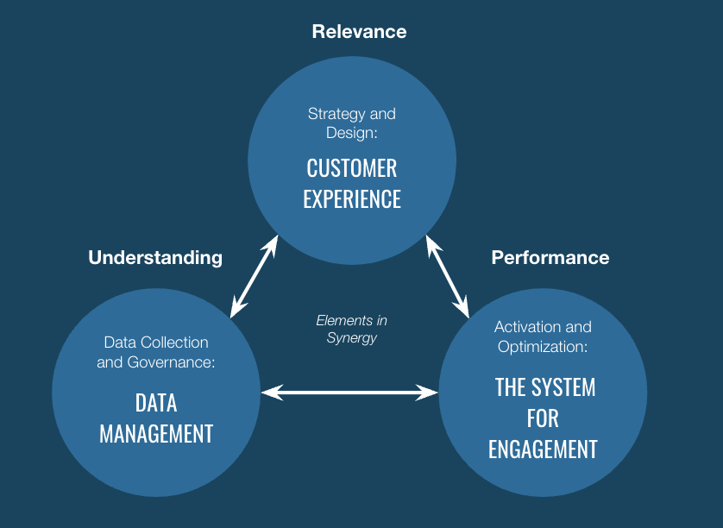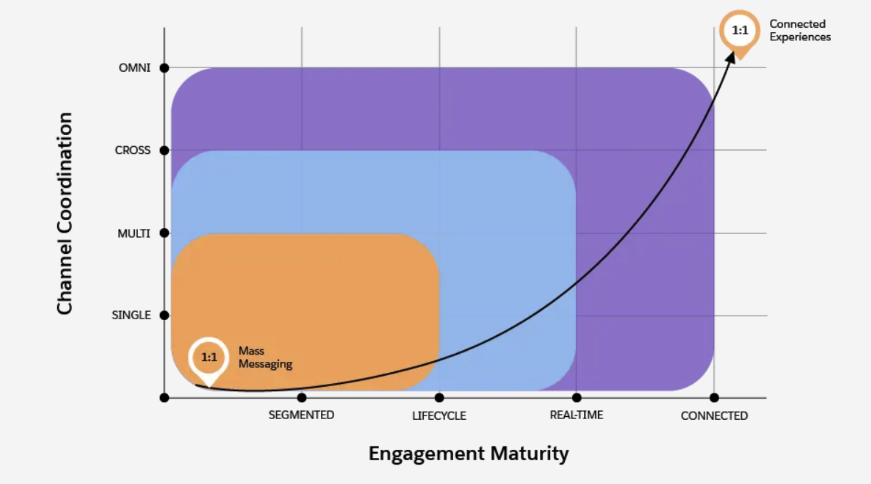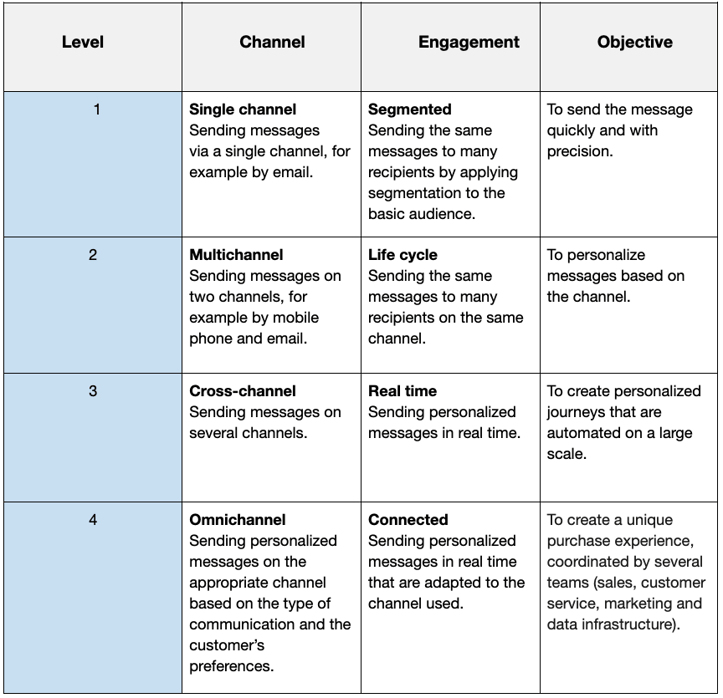Vice-President Data & Customer Experience, Partner
The engagement system: A critical tool for achieving relationship marketing success
Vice-President Data & Customer Experience, Partner
My previous two articles covered the importance of data and customer experience to the success of a relationship marketing program. This last article will be on engagement systems, which are essential for completing the picture. The chart below reiterates the various components needed to support a successful relationship marketing program. The engagement system is a technological tool for materializing the value attributed to each interaction with a consumer.

What is a (marketing) engagement system?
The simplest definition of an engagement system is it’s a vehicle used by a brand to communicate or interact with a user or consumer (it can also focus on employees).
To take a simplistic example, a tool that enables an ad banner to be pushed to a potential customer on Facebook can be considered an engagement system, since it communicates a message to an audience (interaction with a target audience). The same example can be applied to the presentation of relevant content to visitors of a website.
There is a relationship between engagement systems and points of contact. An engagement system must allow interaction with the user from their point of contact with the brand.
Several points of contact must be considered:
- online sources, such as computers (personal or laptop), tablets or mobile phones; and
- offline sources, including stores and in-person events.
The methods of interaction used can include a website, mobile app, social networks, ad banners, email, text, chatbots, etc.
We really can’t consider it a “system” without the idea of orchestration (involving more than one point of contact or channel). There needs to be a minimum level of complexity in the management of messages sent to consumers; a technological tool that manages a single interaction on a single channel and one point of contact would not really be considered an engagement system.
As you might imagine, marketing automation systems or customer journey builders are engagement systems because they enable communication with an audience on several channels and platforms.
What types of engagement systems are available?
There are still two elements we haven’t covered yet in this article: systems of record and systems of intelligence or insight. These are combined with engagement systems to make the latter operational and achieve better performance.
Systems of record let you save data on profiles and customers, while systems of intelligence generate the intelligence you need to create value (segmentation, understanding of behaviour, etc.). We briefly covered these issues in our article on data and relationship marketing.
We can group marketing engagement systems into two major families of tools.
Marketing automation tools
These are tools focused on the operational efficiency of marketing campaigns (for example, sending an email on Black Friday or when an account has been opened). The most well known are those that automate the sending of emails or texts, but the same process can be applied to media advertising.
There are two different types of business rule for communications automation: automation based on user events (behaviour on a site or mobile app, transactions, etc.) and emails scheduled around a life cycle or user life events (new customer, birthday, purchase of real estate, etc.).
Personalized experiences are often applied to segments (groups) and this kind of tool is highly centred on marketing campaigns (cross-management of marketing channels). Most email and customer relationship management platforms offer this kind of functionality. These platforms use zero- and first-party business data to ensure the relevance of communications.
Customer journey builders
These tools let you visually create a sequence of interactions with the consumer. A marketing specialist defines the scenarios within the tool and indicates the types of platforms (office, mobile, email) on which interactions will be managed. These are much more advanced tools that require good customer journey mapping (an exercise we presented briefly in a previous article). Compared with automation tools, customer journey builders are much more focused on the customer (as opposed to marketing campaigns and channels). Some providers offer individual (one-to-one) personalization in real time.
Journey builders are not stand-alone tools, but need to be combined with marketing automation tools or content management systems (CMS). These tools require a huge amount of high-quality primary (first-party) data. They are enhanced with artificial intelligence (AI) which enables marketers to better determine the next best action/activity/offer.
Customer data platform sellers, like Segment, Adobe, and Salesforce, offer this kind of journey builder as part of their products.
Understanding the customer (including the journey) and the quality of primary data (including persistent identifiers such as email addresses) are indispensable prerequisites for maximizing the use of this type of tool.
How to choose an engagement system?
The choice of an engagement system is related to the level of an organization’s digital, marketing, and operational maturity. Acquiring a customer data platform with a journey builder without having first collected primary data and mapped the customer journey will mean failure for this initiative. Operational and cultural realities are extremely important factors to consider when choosing a solution.
Salesforce has developed an intuitive conceptual framework for positioning a company within a marketing operations maturity matrix. The chart below shows the levels and the table that follows summarizes each level.

This table, taken from the Salesforce training site, describes the characteristics of each phase.

The takeaways from the above are that the more your marketing channels increase in number, the more these channels become complex to coordinate and require a certain investment in terms of resources (people, process, platform). As a result, the organization needs to be equipped with tools, processes, human resources, data, and intelligence to ensure it can deliver a unique experience to its customers. Engagement and data strategies are necessary to plan a migration from one phase to another (for example, to move from level 1 to level 2).
Here are a few very simple questions to ask yourself before obtaining an engagement tool or platform:
- What are your business objectives in terms of relationship marketing and customer engagement (for example, to increase retention of X)?
- Have you developed a clear and functional engagement or relationship marketing strategy?
- At the current time, are you using indicators to measure the success of your relationship marketing or engagement strategy?
- Do you have a good understanding of your customers (including their journey)?
- Do you have zero- and first-party data to activate?
- Do you have content that is relevant to your various segments?
- What is your skill level internally with regard to the operation of a relationship marketing program?
- Have you developed a multicriteria matrix (in sync with your IT service and in-house skills) for choosing an engagement system?
One important point to keep in mind: If you don’t have primary data, you should first develop an email acquisition strategy. This will let you start building more lasting audiences. At this stage your engagement system could be a mass emailing platform with basic functionalities (segmentation, A/B testing, automation, emailing, template creation, etc.).
*
I hope this series of articles has clarified the three key components—data, customer experience, and engagement systems—for a successful and efficient relationship marketing program.
If you have any questions or would like help with how your data, customer experience, or engagement systems can support your relationship marketing program, please get in touch with us!













